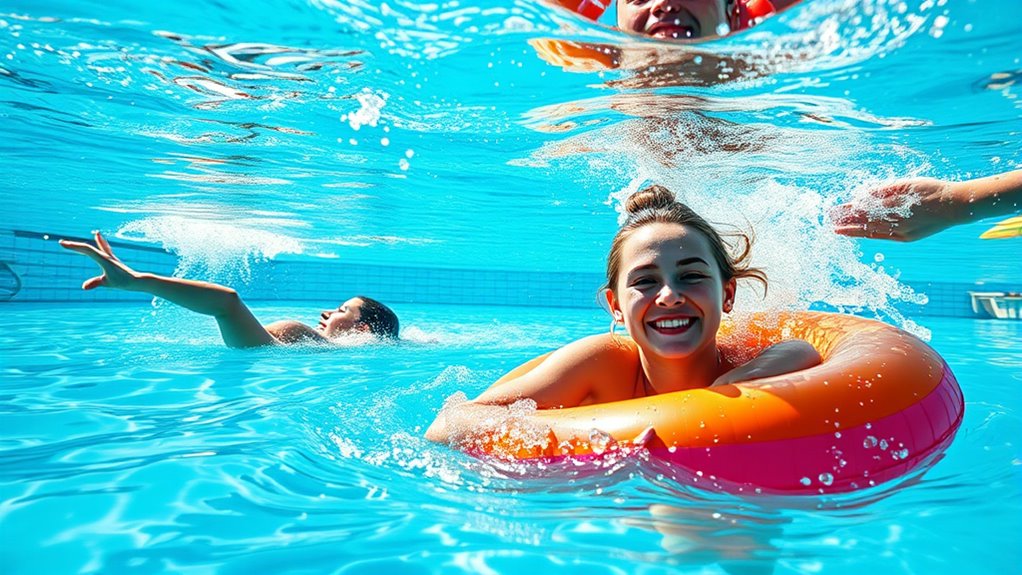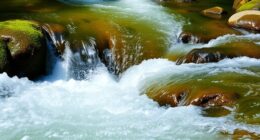To take great poolside and underwater photos, use soft natural light during early mornings or late afternoons for vibrant images. Get close to your subject and stay in clear, well-lit areas to improve clarity. Use a polarizing filter during midday to reduce glare, and add artificial lighting underwater to bring out colors. Adjust your camera settings—low ISO, faster shutter speeds, and wider apertures—to capture sharp, lively shots. Keep exploring to discover more tips for stunning aquatic photos.
Key Takeaways
- Shoot during early morning or late afternoon for soft, natural lighting and vibrant poolside photos.
- Use a polarizing filter midday to reduce glare and reflections on water surfaces.
- Get close to underwater subjects and utilize artificial lighting or flashes for clear, colorful images.
- Set your camera with low ISO, narrow aperture, and fast shutter speed to capture crisp poolside and underwater shots.
- Experiment with water’s reflective qualities and shifting light to create dynamic, creative photos.

Taking stunning poolside and underwater photos requires more than just a good camera; it’s about understanding how to work with water’s unique qualities. Water can be tricky—reflective and constantly shifting—so lighting conditions play a vital role in capturing sharp, vibrant images. When shooting poolside, aim for times when natural light is soft, like early morning or late afternoon, to avoid harsh shadows and overexposed highlights. If you’re shooting during midday, use a polarizing filter to cut down on glare and reflections that can wash out your shot. Underwater, lighting becomes even more essential because water absorbs and diffuses light, often leading to dull or bluish images. To combat this, get as close as possible to your subject and shoot in clear, well-lit conditions. If you’re diving deeper, consider using artificial lighting or underwater flash to restore true colors and add clarity. Additionally, understanding color temperature adjustments can help you achieve more natural-looking underwater photos.
Your camera settings are equally important to get right. For poolside shots, set your camera to a lower ISO—around 100-200—to minimize grain and guarantee crispness. Use a narrow aperture (higher f-stop) to increase depth of field, keeping both foreground and background in focus. Adjust your shutter speed to freeze motion, especially if there are splashes or playful movements. A shutter speed of 1/500 sec or faster usually works well. When shooting underwater, you’ll want to switch to a faster shutter speed too, to avoid motion blur from water movement. Keep your ISO low but be prepared to increase it slightly if lighting is dim, especially at greater depths. Use a wider aperture (like f/2.8 to f/4) to let in more light, which helps counteract the light loss underwater. Many cameras have specific underwater modes—if yours does, activate them to optimize settings automatically.
Frequently Asked Questions
What Are the Best Camera Settings for Underwater Shots?
When shooting underwater, you should adjust your camera settings to optimize lighting and color correction. Use a macro mode for close-ups and set a higher ISO to handle low light. Adjust your white balance for accurate colors, and consider using a wide aperture to get more light in. Make sure to enable any underwater or underwater scene modes on your camera, and test different lighting adjustments to get vibrant, clear shots.
How Can I Prevent Water Spots on My Lens?
Oh, water spots—nature’s sneaky way of ruining your perfect shot! To prevent them, you need to master lens cleaning before diving in. Use a soft cloth to wipe your lens and keep it dry. Investing in water resistant gear is a wise move, but don’t rely on it alone. Always rinse your lens with fresh water after poolside or underwater adventures, then dry it thoroughly to keep those pesky spots at bay.
What Accessories Improve Poolside Photography?
To improve poolside photography, consider using waterproof gear like a protective case or waterproof camera to prevent water damage. Additionally, enhance your shots with portable poolside lighting or reflectors to control natural light and avoid harsh shadows. These accessories help you capture clearer, more vibrant images in challenging conditions, ensuring your photos look professional and fun, whether you’re shooting poolside or underwater.
How Do I Capture Clear Action Shots Underwater?
To capture clear action shots underwater, focus on proper underwater lighting to enhance visibility and color. Use fast shutter speeds to freeze motion and prevent blurriness. Make sure your diving equipment includes a waterproof camera with good stabilization. Position yourself strategically to anticipate movements and get closer to your subject. Adjust your camera settings for ideal exposure, and stay patient to capture those perfect, sharp action moments beneath the surface.
What Safety Precautions Should I Take While Shooting Underwater?
Imagine you’re a diver exploring a vibrant coral reef; safety is your oxygen. Always check your underwater lighting to avoid accidents, and guarantee pool safety by staying aware of your surroundings. Use waterproof gear correctly, avoid diving alone, and keep a safety float nearby. Following these precautions helps you stay safe while capturing stunning shots, turning your underwater adventure into a secure and enjoyable experience.
Conclusion
Now, as you capture those perfect poolside and underwater moments, remember that sometimes the best shots happen when you least expect them—like that unexpected splash or a sudden burst of sunlight. Keep your camera ready and your eyes open; the most memorable photos often come from happy accidents. So, relax, have fun, and stay alert—you might just snap the shot that surprises everyone and makes your collection truly unforgettable.










